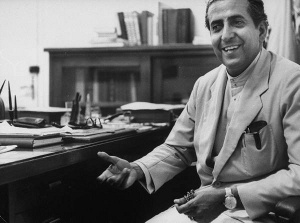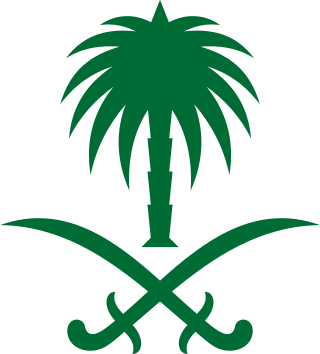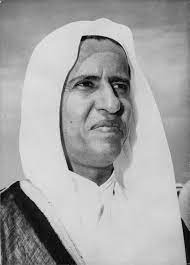
The history of Saudi Arabia as a nation state began with the emergence of the Al Saud dynasty in central Arabia in 1727 and the subsequent establishment of the Emirate of Diriyah. Pre-Islamic Arabia, the territory that constitutes modern Saudi Arabia, was the site of several ancient cultures and civilizations; the prehistory of Saudi Arabia shows some of the earliest traces of human activity in the world.

Abdulaziz bin Abdul Rahman Al Saud, known in the Western world mononymously as Ibn Saud, was the founder and first king of Saudi Arabia, reigning from 23 September 1932 until his death in 1953. He had ruled parts of the kingdom since 1902, having previously been Emir, Sultan, and King of Nejd, and King of Hejaz.

Fahd bin Abdulaziz Al Saud was King and Prime Minister of Saudi Arabia from 13 June 1982 until his death in 2005. Prior to his ascension, he was Crown Prince of Saudi Arabia from 1975 to 1982. He was the eighth son of King Abdulaziz, the founder of modern Saudi Arabia.

The House of Al Saud is the ruling royal family of Saudi Arabia. It is composed of the descendants of Muhammad bin Saud, founder of the Emirate of Diriyah, known as the First Saudi State, (1727–1818), and his brothers, though the ruling faction of the family is primarily led by the descendants of Ibn Saud, the modern founder of Saudi Arabia. It forms a subtribe of the larger prominent ancient Banu Hanifa tribe of Arabia, from which well known 7th century Arabian theologist Maslama ibn Ḥabīb originates. The most influential position of the royal family is the King of Saudi Arabia, an absolute monarch. The family in total is estimated to comprise 15,000 members; however, the majority of power, influence and wealth is possessed by a group of about 2,000 of them. Some estimates of the royal family's wealth measure their net worth at $1.4 trillion. This figure includes the market capitalization of Saudi Aramco, the state oil and gas company, and its vast assets in fossil fuel reserves, making them the wealthiest family in the world and the wealthiest in recorded history.

Abdul Rahman bin Faisal Al Saud was the last emir of Nejd, reigning from 1875 to 1876 and from 1889 to 1891. He was the youngest son of Emir Faisal bin Turki bin Abdullah and the father of Abdulaziz, the founder of the Kingdom of Saudi Arabia.

The Rashidi dynasty, also called Al Rashid or the House of Rashid, was a historic Arabian House or dynasty that existed in the Arabian Peninsula between 1836 and 1921. Its members were rulers of the Emirate of Ha'il and the most formidable enemies of the House of Saud, rulers of the Emirate of Nejd. They were centered in Ha'il, a city in northern Najd that derived its wealth from being on the route of the Hajj pilgrimage to Mecca, and was also a commercial center. The rulers of Ha'il were the sons of Abdullah bin Rashid, founder of the dynasty.
Faisal bin Turki Al Saud was the second ruler of the Second Saudi State and seventh head of the House of Saud.

Sa'ad bin Abdul Rahman Al Saud was the brother of Abdulaziz, Emir of Nejd. He was one of Abdulaziz's most devoted supporters and a key lieutenant in his early military campaigns.

Madawi al-Rasheed, is a British citizen of Saudi origin and a professor of social anthropology. Al-Rasheed has held a position at the Department of Theology and Religious Studies in King's College London and as a Visiting Professor at the Middle East Centre at the London School of Economics and Political Science. She gives occasional lectures in the United States, Europe, and the Middle East. She is the granddaughter of Muhammad bin Talāl al-Rashid, the last prince of the Emirate of Ha'il, which was conquered by the Al-Saud in the early 20th century. She has written several books and articles in academic journals on the Arabian Peninsula, Arab migration, globalisation, gender, and religious transnationalism. As of 2016, she is a Visiting Research Professor at the Middle East Institute at the National University of Singapore.

Abdullah Tariki, also known by the alternate spelling of his last name as al-Turayqi and nicknamed the Red Sheikh, was a Saudi politician and government official. He served as the first oil minister of Saudi Arabia, appointed by King Saud, and was co-founder of the Organization of Petroleum Exporting Countries (OPEC).

Bandar bin Abdulaziz Al Saud was the tenth son of King Abdulaziz. At the time of his death, he was the eldest surviving member of the Saudi ruling family.

The unification of Saudi Arabia was a military and political campaign in which the various tribes, sheikhdoms, city-states, emirates, and kingdoms of most of the central Arabian Peninsula were conquered by the House of Saud, or Al Saud. Unification started in 1902 and continued until 1932, when the Kingdom of Saudi Arabia was proclaimed under the leadership of Abdulaziz, known in the West as Ibn Saud, creating what is sometimes referred to as the Third Saudi State, to differentiate it from the Emirate of Diriyah, the First Saudi State and the Emirate of Nejd, the Second Saudi State, also House of Saud states.
Noura bint Abdul Rahman Al Saud was the eldest daughter of Abdul Rahman bin Faisal, Emir of Nejd, and the elder sister and adviser of King Abdulaziz of Saudi Arabia. Madawi Al Rasheed argues that she is the first example of Saudi royal women who are introduced to support the view of a progressive royalty.

The Arabian Peninsula People's Union was a Nasserist political party in Saudi Arabia. The APPU was founded in 1959 by Nasser Al Saeed whilst in exile in Beirut. Saeed had been exiled due to his leadership of the ARAMCO strikes in 1956. The APPU was regarded as one of the most important and most diverse opposition groups.
Muhammad bin Saud Al Muqrin Al Saud, also known as Ibn Saud, was the emir of Diriyah and is considered the founder of the First Saudi State and the Saud dynasty, named after his father, Saud bin Muhammad Al Muqrin. His reign lasted between 1727 and 1765.
The Arab National Liberation Front was an exile-based Saudi opposition movement. ANLF was founded in Cairo in December 1962, through the merger of the National Liberation Front(جبهة التحرير الوطني) and the Free Princes Movement. Talal bin Abdulaziz became the general secretary of ANLF. The formation of a 15-member political bureau was announced when the organization was founded.

Sectarianism in Saudi Arabia refers to the Saudi government's "top-down push towards sectarian polarization" between the Sunni majority, and Shi'ite minority. This encompasses anti-Shi'ite policies by the Saudi regime, as well as tensions between the Sunni majority and the Shi'ite minority. The Saudi government is often viewed to be oppressing the Shi'ite community, who constitute up to 15% of the Saudi population. This occurs against the backdrop of the broader Iran-Saudi Arabia proxy conflict, since Iran is a Shi'ite republic.

Musaid bin Abdul Rahman Al Saud was a Saudi Arabian statesman and official who served as the Saudi Arabian minister of interior in 1960 and as the minister of finance from 1962 to 1975. A member of the House of Saud, he was the son of Abdul Rahman bin Faisal Al Saud and Amsha bint Faraj Al Ajran Al Khalidi. Prince Musaid was one of the younger half-brothers of King Abdulaziz and was one of the senior royals who shaped the succession of the rulers during his lifetime.
Tarfa bint Abdullah Al Sheikh was the third wife and one of the 22 consorts of Abdulaziz bin Abdul Rahman, Emir of Nejd, and the mother of Princess Noura and King Faisal.

Saudi Founding Day, officially the Founding Day, is a public holiday in Saudi Arabia celebrated annually on February 22 to commemorate the enthronement of Muhammad bin Saud as the emir of the oasis town of Diriyah in 1727 following the death of his father Saud al-Muqrin, the eponymous ancestor of the al-Saud family. His hereditary succession is considered as the prelude to the inception of the First Saudi State, the antecedent to the Second Saudi State and present-day Kingdom of Saudi Arabia. It was founded in 2022 on its 295th anniversary when King Salman bin Abdulaziz issued a royal decree that designated it as a legal holiday to be observed as per the Gregorian calendar. It is one of the three non-religious national holidays observed in the country, other being the Saudi National Day and Saudi Flag Day.















